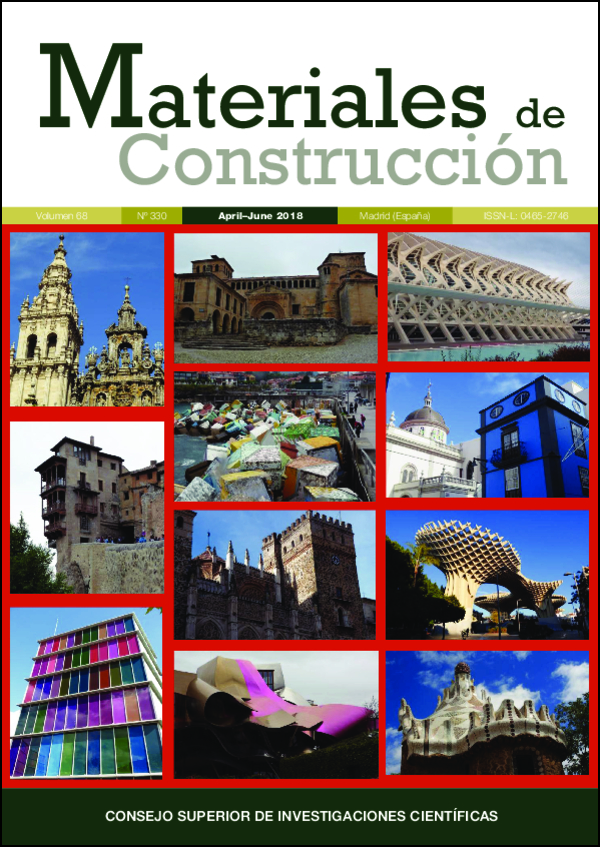Prestaciones del cemento portland ultrafino
DOI:
https://doi.org/10.3989/mc.2018.03317Palabras clave:
Cemento Portland, Humo de sílice, Resistencia a compresión, Porosimetría de Hg, Análisis térmicoResumen
La densidad de empaquetamiento del producto final se puede mejorar cuando se mezclan varios conglomerantes y adiciones de diferente finura. En este trabajo se estudiaron varias mezclas de cemento ultrafino y humo de sílice para optimizar las propiedades de los materiales de base cemento. Esta investigación se realizó con morteros fabricados con dos tipos de cemento (cemento Portland ultrafino y cemento Portland común) y dos tipos de humo de sílice con diferentes tamaños de partícula. Se seleccionaron dos porcentajes de sustitución de cemento Portland por humo de sílice (4% y 10%) que se mezclaron mecánicamente. Los resultados revelaron que la mezcla del humo de sílice más fino con el cemento grueso mejora las propiedades mecánicas y el refinamiento de la distribución del tamaño de poro a edades avanzadas. Esta mejora de resistencias y reducción del tamaño de poro era menor en el caso del cemento ultrafino con el humo de sílice.
Descargas
Citas
Sanjuán, M.A.; Menéndez, E.; Argiz ,C.; Moragues, A. (2016) Coal bottom ash research program focused to evaluate a potential portland cement constituent. In: Proceedings of II International Conference on Concrete Sustainability. Madrid, Spain, June, 532-543.
Bentz, D.P.; Haecker, C.J. (1999) An argument for using coarse cements in high performance concretes. Cem. Concr. Res. 29[4], 615–618. https://doi.org/10.1016/S0008-8846(98)00201-4
Sanjuán, M.A.; Argiz, C.; Gálvez, J.C.; Moragues, A. (2015) Effect of silica fume fineness on the improvement of Portland cement strength performance. Constr. Build. Mater. 96, 55–64. https://doi.org/10.1016/j.conbuildmat.2015.07.092
Kuhlmann, K.; Ellerbrock, H.G.; Sprung, S. (1985) Particle-size distribution and properties of cement. Part I: Strength of portland cement. ZKG International Cement-Lime-Gypsum. Edition B. 38[4], 169–178.
Thomas, J.J.; Jennings, H.M.; Chen, J.J. (2009) Influence of Nucleation Seeding on the Hydration Mechanisms of Tricalcium Silicate and Cement. J. Phys. Chem. C. 113 [11], 4327–4334. https://doi.org/10.1021/jp809811w
Goldman, A.; Bentur, A. (1993) The influence of microfillers on enhancement of concrete strength. Cem. Concr. Res. 23 [4], 962–972. https://doi.org/10.1016/0008-8846(93)90050-J
Feng, N.Q.; Shi, Y.X.; Hao, T.Y. (2000) Influence of ultrafine powder on the fluidity and strength of cement paste. Adv. Cem. Res. 12 [3], 89–95. https://doi.org/10.1680/adcr.2000.12.3.89
Roux, N.; Andrade, C.; Sanjuán, M. (1996) Experimental Study of Durability of Reactive Powder Concretes. J. Mater. Civ. Eng. 8 [1], 1–6. https://doi.org/10.1061/(ASCE)0899-1561(1996)8:1(1)
Fernández, A.; Alonso, M.C.; García –Calvo, J.L.; Lothenbach, B. (2016) Influence of the synergy between mineral additions and Portland cement in the physical-mechanical properties of ternary binders. Mater. Construcc. 66 [324], October- December e097. https://doi.org/10.3989/mc.2016.10815
EN 197-1:2011 Cement - Part 1: Composition. specifications and conformity criteria for common cements.
EN 196-1:2016 Methods of testing cement - Part 1: Determination of strength. European Committee for Standardization (CEN). Brussels.
EN 196-2:2013 Method of testing cement. Chemical analysis of cement.
UNE 83988-1:2008 Concrete durability. Test methods. Determination of the electrical resistivity. Part 1: Direct test (reference method). AENOR. Madrid.
Tobón, J.I.; Payá, J.; Borrachero, M.V.; Soriano, L.; Restrepo, O.J. (2012) Determination of the optimum parameters in the high resolution thermogravimetric analysis (HRTG) for cementitious materials. J. Therm. Anal. Calorim.107 [1], 233–239. https://doi.org/10.1007/s10973-010-0997-0
Kong, D.Y.; Du, X.F.; Wei, S.; Zhang, H.; Yang, Y.; Shah, S.P. (2012) Influence of nano-silica agglomeration on microstructure and properties of the hardened cement-based materials. Constr. Build. Mater. 37, 707–715. https://doi.org/10.1016/j.conbuildmat.2012.08.006
Bonavetti, V.L.; Castellano, C.; Donza, H.; Rahhal, V.F.; Irassar, E.F. ((2014) Cement with silica fume and granulated blast-furnace slag: strength behavior and hydratation. Mater. Construcc. 64 [315], July-September e25. https://doi.org/10.3989/mc.2014.04813
Poon, C.S.; Kou, S.C.; Lam, L. (2006) Compressive strength chloride diffusivity and pore structure of high performance metakaolin and silica fume concrete. Constr. Build. Mater. 20 [10], 858–865. https://doi.org/10.1016/j.conbuildmat.2005.07.001
Elahi, A.; Basheer, P.A.M.; Nanukuttan, S.V.; Khan, Q.U.Z. (2010) Mechanical and durability properties of high performance concretes containing supplementary cementitious materials. Constr. Build. Mater. 24 [3], 292–299. https://doi.org/10.1016/j.conbuildmat.2009.08.045
Mazloom, M.; Ramezanianpour, A.A.; Brooks, J.J. (2004) Effect of silica fume on mechanical properties of high-strength concrete. Cem. Concr. Compos. 26 [4], 347–357. https://doi.org/10.1016/S0958-9465(03)00017-9
Senhadji Y, Escadeillas G, Mouli M, Khelafi H, Benosman. (2014) Influence of natural pozzolan silica fume and limestone fine on strength acid resistance and microstructure of mortar. Powder Technol. 254, 314–323. https://doi.org/10.1016/j.powtec.2014.01.046
Wang, A.Q.; Zhang, C.Z.; Zhang, N.S. (1999) The theoretic analysis of the influence of the particle-size distribution of cement system on the property of cement. Cem. Concr. Res. 29 [11], 1721–1726. https://doi.org/10.1016/S0008-8846(99)00148-9
Mahmoud, S.; Reyes, E.; Moragues, A. (2010) Evolution of microstructure and mechanical behavior of concretes utilized in marine environments. Mater. Des. 31[7], 3412-3418. https://doi.org/10.1016/j.matdes.2010.01.045
Huang, C.Y.; Feldman, R.F. (1985) Hydration reactions in portland cement-silica fume blends. Cem. Concr. Res. 15[4], 585–592. https://doi.org/10.1016/0008-8846(85)90056-0
Langan, B.W.; Weng. K.; Ward, M.A. (2002) Effect of silica fume and fly ash on heat of hydration of Portland cement. Cem. Concr. Res. 32[7], 1045–51. https://doi.org/10.1016/S0008-8846(02)00742-1
Publicado
Cómo citar
Número
Sección
Licencia
Derechos de autor 2018 Consejo Superior de Investigaciones Científicas (CSIC)

Esta obra está bajo una licencia internacional Creative Commons Atribución 4.0.
© CSIC. Los originales publicados en las ediciones impresa y electrónica de esta Revista son propiedad del Consejo Superior de Investigaciones Científicas, siendo necesario citar la procedencia en cualquier reproducción parcial o total.
Salvo indicación contraria, todos los contenidos de la edición electrónica se distribuyen bajo una licencia de uso y distribución “Creative Commons Reconocimiento 4.0 Internacional ” (CC BY 4.0). Consulte la versión informativa y el texto legal de la licencia. Esta circunstancia ha de hacerse constar expresamente de esta forma cuando sea necesario.
No se autoriza el depósito en repositorios, páginas web personales o similares de cualquier otra versión distinta a la publicada por el editor.
















